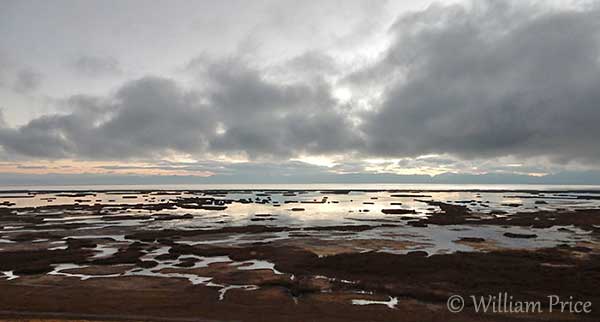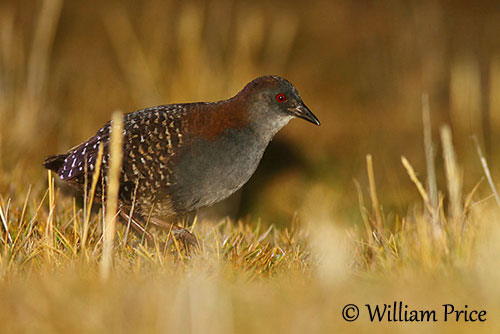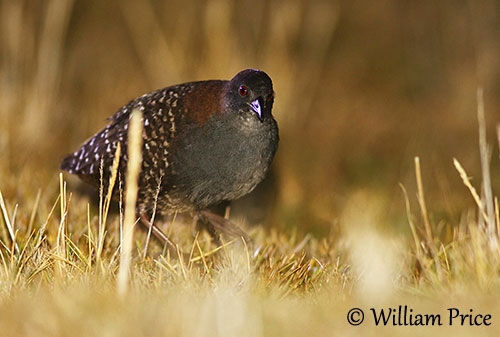
PROTECTION / THREATS / STATUS:
The Junin Rail is threatened by habitat degradation caused by pollution of water by mining industry, and by fluctuation of water levels involving the desiccation of the fringing vegetation.
Predation by pampas cats (Leopardus colocolo pajeros) is also a problem, especially during periods of drought when the most part of the marsh becomes accessible to terrestrial predators.
The population is roughly estimated to number 600/1,700 mature individuals and it is suspected to be declining.
The Junin Rail is currently listed as Endangered.
Fr: Râle du Junín
Ang: Junin Rail – Junin Crake
All: Juninralle
Esp: Polluela del Junín
Ita: Rallo del Junin
Nd: Junínral
Sd: Junínrall
Photographer:
William Price
PBase-tereksandpiper & Flickr William Price
Text by Nicole Bouglouan
Sources:
HANDBOOK OF THE BIRDS OF THE WORLD Volume 3 by Josep del Hoyo-Andrew Elliott-Jordi Sargatal - Lynx Edicions - ISBN : 8487334202
The World's Rarest Birds - De Erik Hirschfeld, Andy Swash, Robert Still – Editeur: Princeton University Press, 2013 – ISBN: 1400844908, 9781400844906 - 360 pages
BIRDS OF PERU by Thomas S. Schulenberg, Douglas F. Stotz, Daniel F. Lane, John P. O’Neill, Theodore A. Parker III – Princeton University Press 2007 ISBN: 978-0-691-13023-1
BirdLife International (1992) Aves Amenazadas de las Américas
Birdwatching Peru - Junin Grebe and Rail
Ciencias.pe - Gallinetita de Junin
The waterbirds of Lake Junin, central Peru

Junin Rail
Laterallus tuerosi
Gruiformes Order – Rallidae Family
INTRODUCTION:
The Junin Rail is often considered a subspecies of L. jamaicensis, but it differs in plumage pattern and colour, and it has different voice. This rail is treated as a full species on this page.
The Junin Rail is sedentary in its restricted range in Lake Junín in C Peru, at 4080 metres of elevation. It feeds on small invertebrates and nests on the ground among the vegetation.
The Junin Rail is threatened by degradation of its restricted habitat caused by pollution and fluctuations of water levels. The small population is suspected to be declining, and the species is currently listed as Endangered.

DESCRIPTION OF THE BIRD:
Biometrics:
Length: 12-13 cm
The Junin Rail has rufous-brown mantle, whereas rest of upperparts is mostly dark brown with conspicuous white barring, including on wings and tail.
Head, throat, neck and breast are dark grey. Belly and vent are heavily barred black and white, but the undertail-coverts are uniformly pale brown to buff.
The bill is blackish. The eyes are reddish. Legs and feet are greenish-yellow.
Male and female are similar.
The juvenile is not described, but it is probably duller than adults.
RANGE:
The Junin Rail is endemic to Lake Junín in central Peru.
HABITAT:
The Junin Rail frequents dense areas with Juncus andecolus, but also open areas with partly flooded moss and short matted grass in the large marshes bordering the lake.
CALLS AND SONGS: SOUNDS BY XENO-CANTO
The Junin Rail gives a rapid “ki-ki-ki-ki-brrr” at night. We can also hear single “chirr” notes. The female utters lower “croo-croo-oo…” calls.
BEHAVIOUR IN THE WILD:
The Junin Rail forages by walking or running among the marshy vegetation while searching for prey. It feeds mainly on small invertebrates, arthropods and larvae, both aquatic and terrestrial.
This species is probably active throughout the day, but it also has crepuscular habits.
The Junin Rail breeds during the rainy season. The nest is on the ground.
It is sedentary in its range.
The Junin Rail is not a good flier and does not swim. It walks and runs when foraging in the marshy vegetation.
REPRODUCTION OF THIS SPECIES:
The Junin Rail breeds in September/October during the rainy season.
This species is known to form semi-colonies, but this behaviour could be the result of the fragmentation of suitable nesting habitat. But this behaviour requires more information.
The Junin Rail nests on or near the ground in the marshy vegetation. The nest is made with grass and rushes and other aquatic plants.
The clutch contains only two eggs.
No more information.
